What’s the best way to deliver an experience that your users love?
Well, just ask them what they want.
That sounds oversimplified but it’s what user feedback is all about.
Engaging with your customers, asking the right questions, and constantly looking for things that can be improved.
And to do that you need an in-app feedback tool that not only supports your business goals but also offers the necessary capabilities to achieve them.
So, in this blog, we’ll explore 13 of the top in-app feedback tools, breaking down their features, pricing, and what makes each one unique.

What is in-app feedback?
In-app feedback refers to the insights and opinions gathered directly from users while they are interacting with your platform.
It allows app developers, product managers, and designers to understand user experiences, preferences, and frustrations in real-time.
Unlike traditional feedback channels like email or customer support, in-app feedback is collected seamlessly within the app, making it more contextual, timely, and relevant.
Why collect in-app feedback?
In-app feedback plays a key role in identifying struggle areas and building tailored experiences. It provides contextual insights by engaging with users at the moment they experience issues or perform an action.
This direct connection to user experiences ensures you’re making data-driven decisions that enhance usability and engagement.
In-app feedback also builds trust with your audience by showing them their opinions matter. By addressing user concerns, you can improve satisfaction, retention, and even app store ratings.
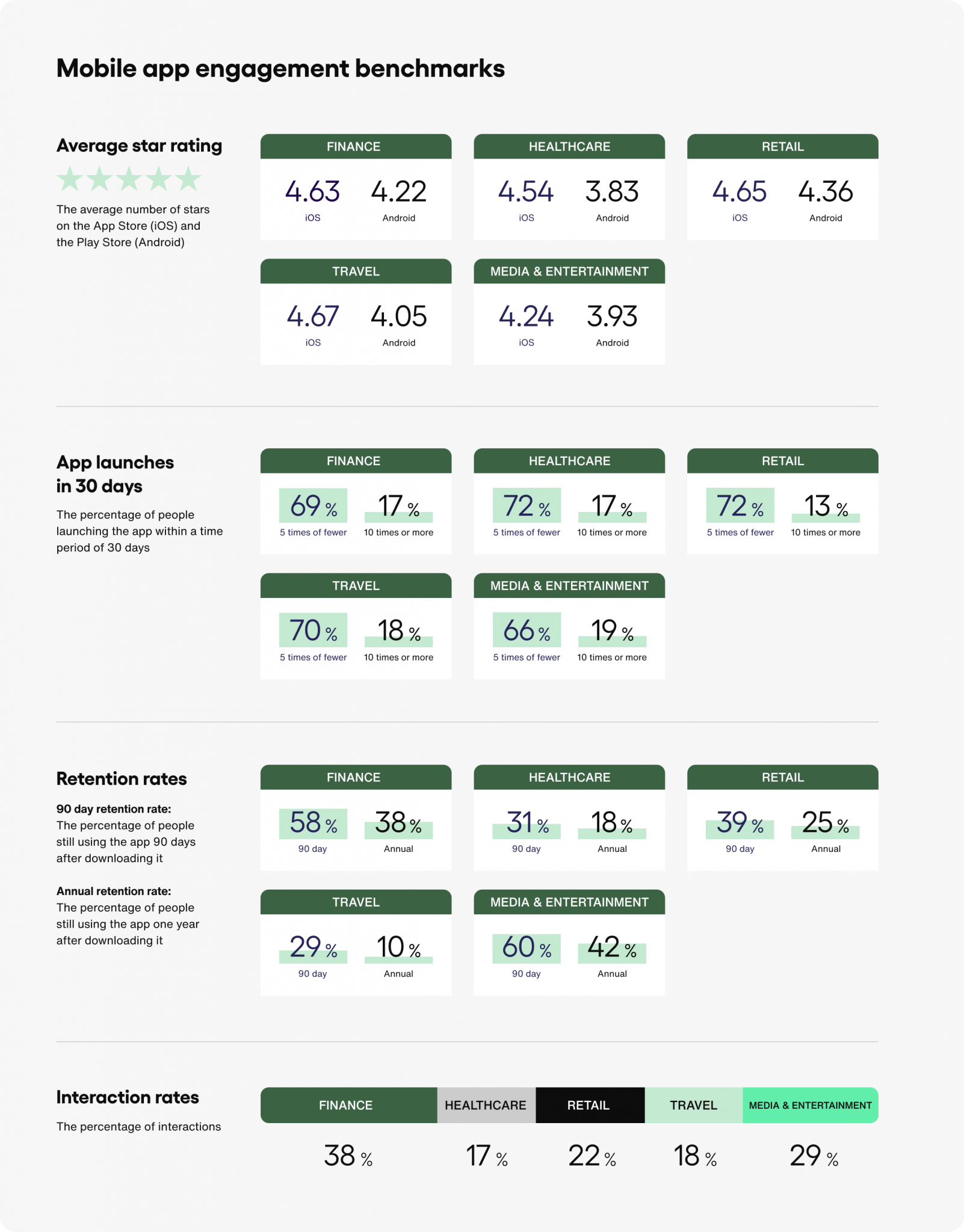
Best in-app feedback tools: Quick overview
- Survicate
- Refiner
- GetFeedback
- Alchemer
- Doorbell
- Pendo
- Mopinion
- Uservoice
- Luciq
- HelpStack
- Usersnap
- Userpilot
Top 12 in-app feedback tools: Comprehensive overview
1. Survicate
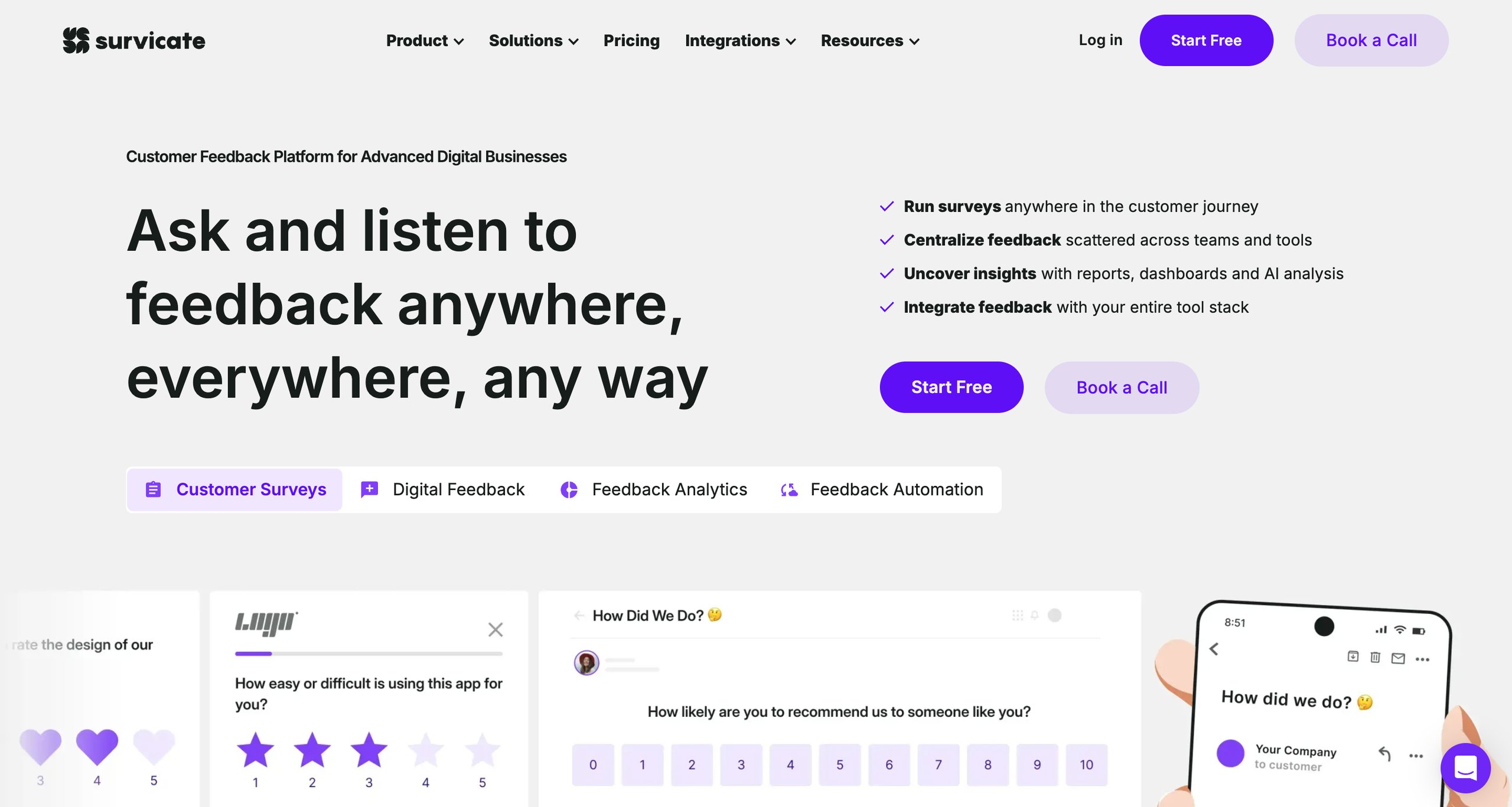
Survicate is one of the most popular feedback tools that enables businesses to create, manage, and launch surveys without disrupting the app experience.
By integrating a lightweight SDK for mobile apps, users can gather actionable insights, identify pain points, and prioritize feature roadmaps effectively.
Apart from automated triggers, and robust filtering options, Survicate also offers the capability to customize surveys to match your app’s branding.
Top features of Survicate
Customizable in-app surveys, event-based triggers, automated recurring surveys, multiple filter options, and sentiment tracking to monitor user satisfaction.
Pros
- Surveys are easy to set up, especially for users who may not be tech-savvy
- Simplifies the process of managing surveys for the product, marketing, and CS teams.
- Wide range of integrations with other platforms
Cons
- Analyzing multiple surveys in the overview section can be overwhelming
- Limited customization options for mobile app surveys
- Lacks advanced features and analytics for running complex surveys
Pricing
Survicate offers mobile surveys at $149/month with a limit of 500 monthly responses.
2. Refiner
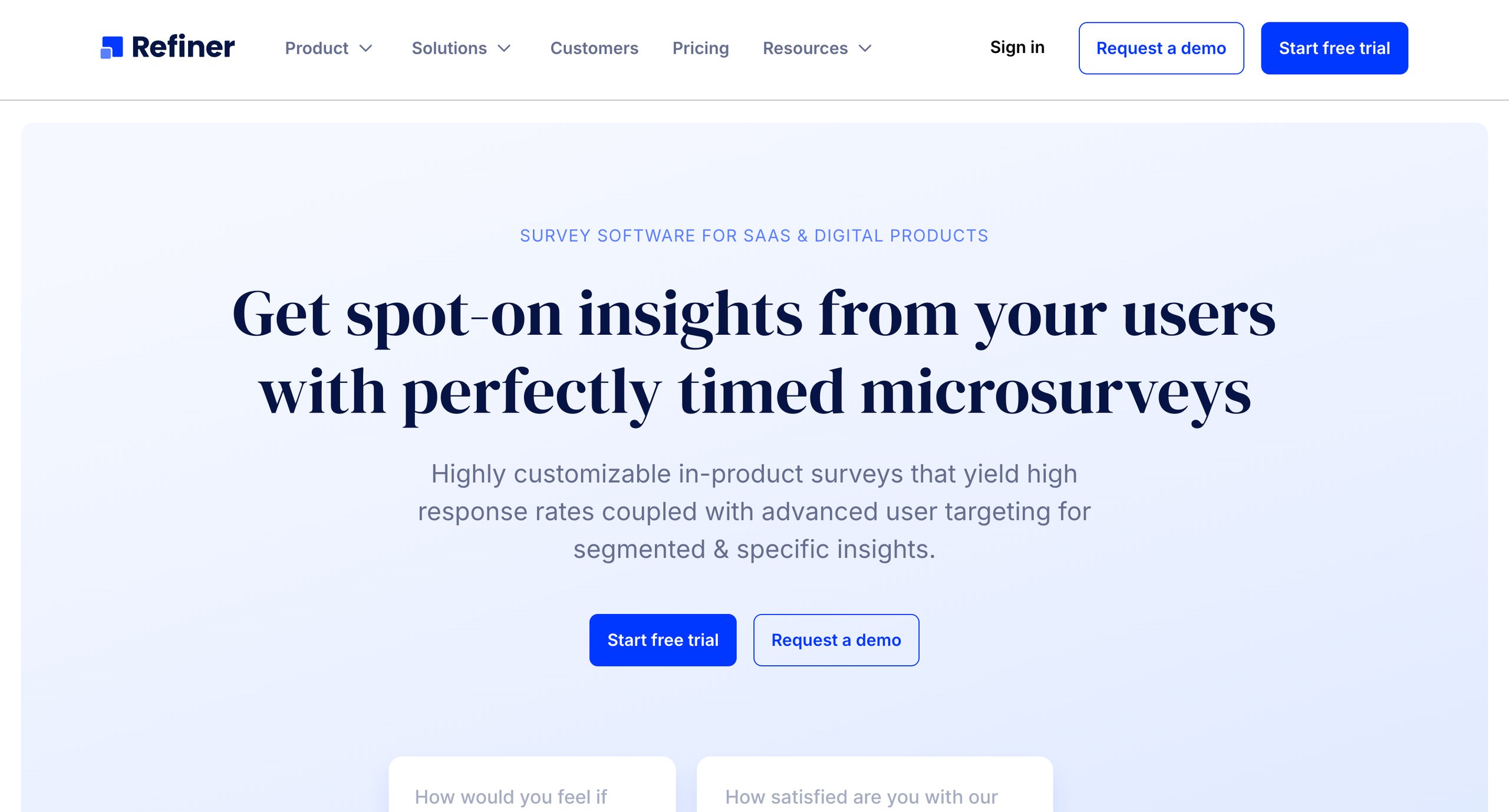
Refiner is a dedicated survey tool for mobile apps that enables businesses to collect high-quality, context-rich feedback seamlessly.
With precise targeting, advanced triggers, and customizable survey designs, the platform helps businesses engage the right users at the right time.
Refiner’s powerful analytics and integration options enable teams to act on insights quickly, boost user engagement, and improve the overall app experience.
Top features of Refiner
Customizable survey templates, advanced launch triggers, 12 question types, dynamic CTAs for post-survey engagement, and automation for optimized workflows.
Pros
- Customizable survey widgets and ready-made templates
- Offers quick and seamless integrations with a lot of platforms
- Easy to view and analyze survey response data
Cons
- Dashboards are not very intuitive
- Limited options for customization and automation
- Not suitable for advanced or complex use cases
Pricing
Refiner offers a 30-day free trial, after which you can opt for its Essentials plan at $99/month for 5k monthly active users (MAUs).
3. GetFeedback
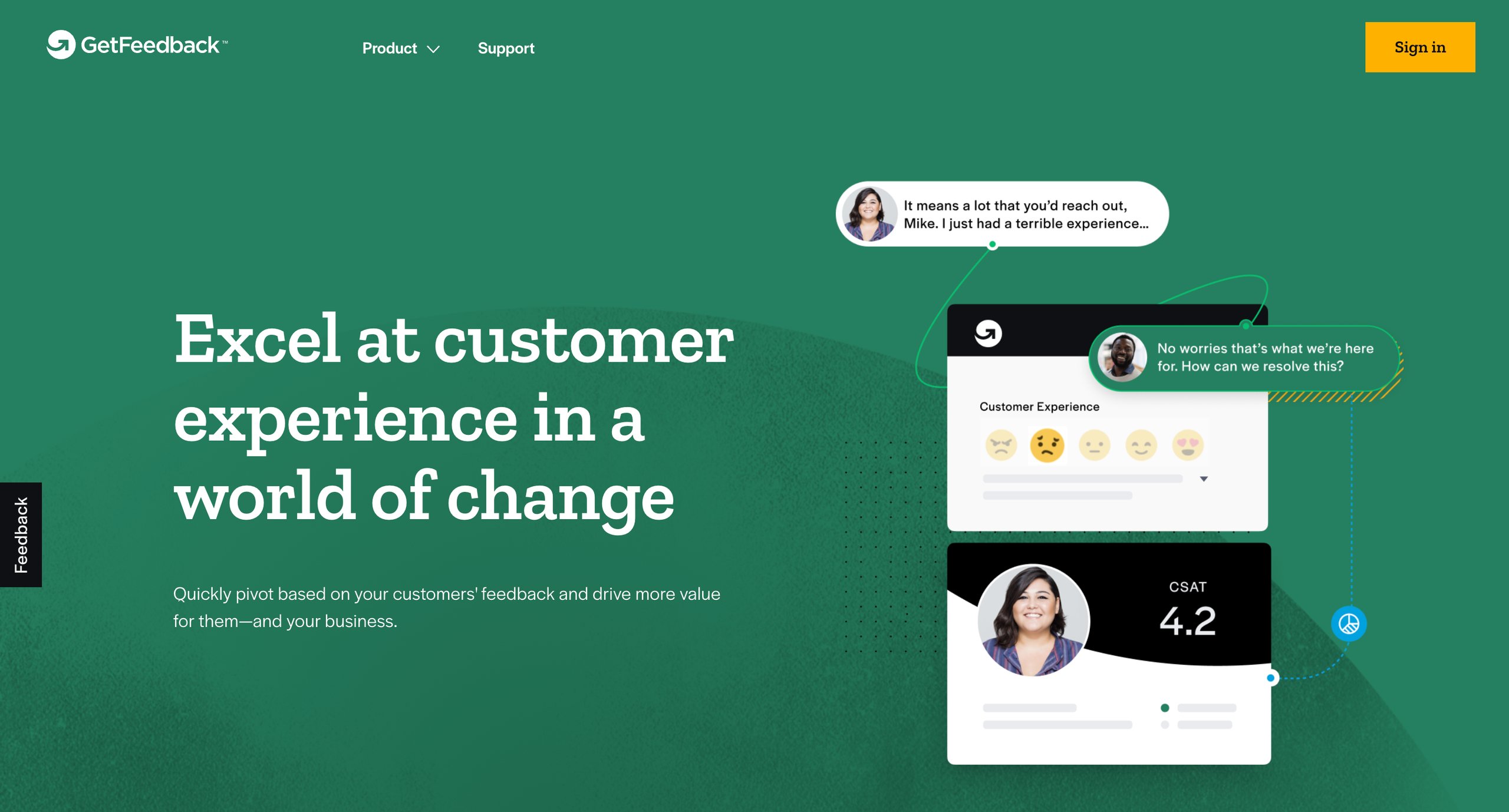
GetFeedback is a leading feedback tool designed to help businesses gather real-time, contextual feedback across multiple customer touchpoints.
With seamless integrations and advanced targeting options, the tool lets businesses personalize surveys, take action on customer feedback quickly, and build a frictionless user experience.
Whether collecting NPS scores, improving app store ratings, or addressing website issues, GetFeedback helps businesses boost satisfaction, and drive meaningful improvements.
Top features of GetFeedback
Survey triggers, advanced targeting options, real-time feedback collection, survey embedding, and converting user feedback into app store ratings.
Pros
- The robust user interface makes it easy to design and manage surveys
- Integration with Salesforce can be automated with triggers
- Highly customizable survey themes and question templates
Cons
- Limited visualization and reporting capabilities
- Lacks the capability to capture video feedback or screen recordings
- High pricing options as compared to competitors offering similar features
Pricing
GetFeedback offers customized pricing options based on your business goals.
4. Alchemer
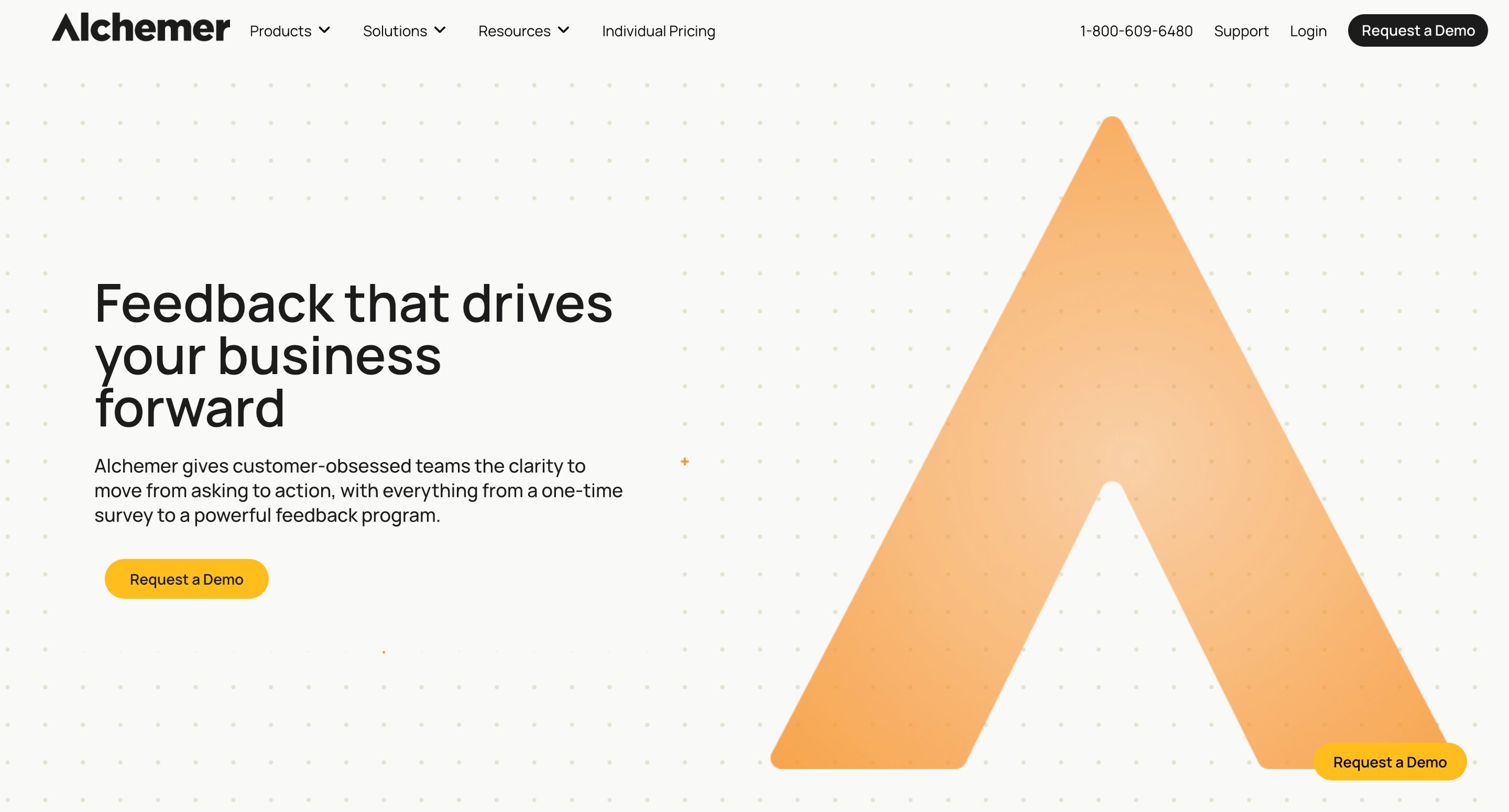
Alchemer is a versatile feedback management tool designed to help businesses easily collect, analyze, and act on customer insights.
Apart from one-time surveys and sophisticated feedback programs, the platform offers useful integrations and advanced workflow automation, ensuring seamless feedback collection.
Alchemer’s AI-driven analysis, role-based dashboards, and powerful reporting tools offer actionable insights to improve customer satisfaction and drive business growth.
Top features of Alchemer
Surveys, workflow automation, AI-powered analysis, role-based dashboards, and advanced reporting tools.
Pros
- Easily create detailed surveys for different goals and audiences
- Integrates seamlessly into your existing workflows
- Wide range of design templates to personalize any survey
Cons
- Manual formatting is often required for better analysis in Excel sheets.
- Integrating the surveys with Salesforce is challenging at times.
- From an end user’s perspective, the look and feel of the surveys can be improved.
Pricing
Alchemer’s free plan has a limit of 3 active surveys and 100 responses per survey. The paid options include a Collaborator plan at $55 per user/per month for unlimited surveys and 75k annual responses.

5. Doorbell
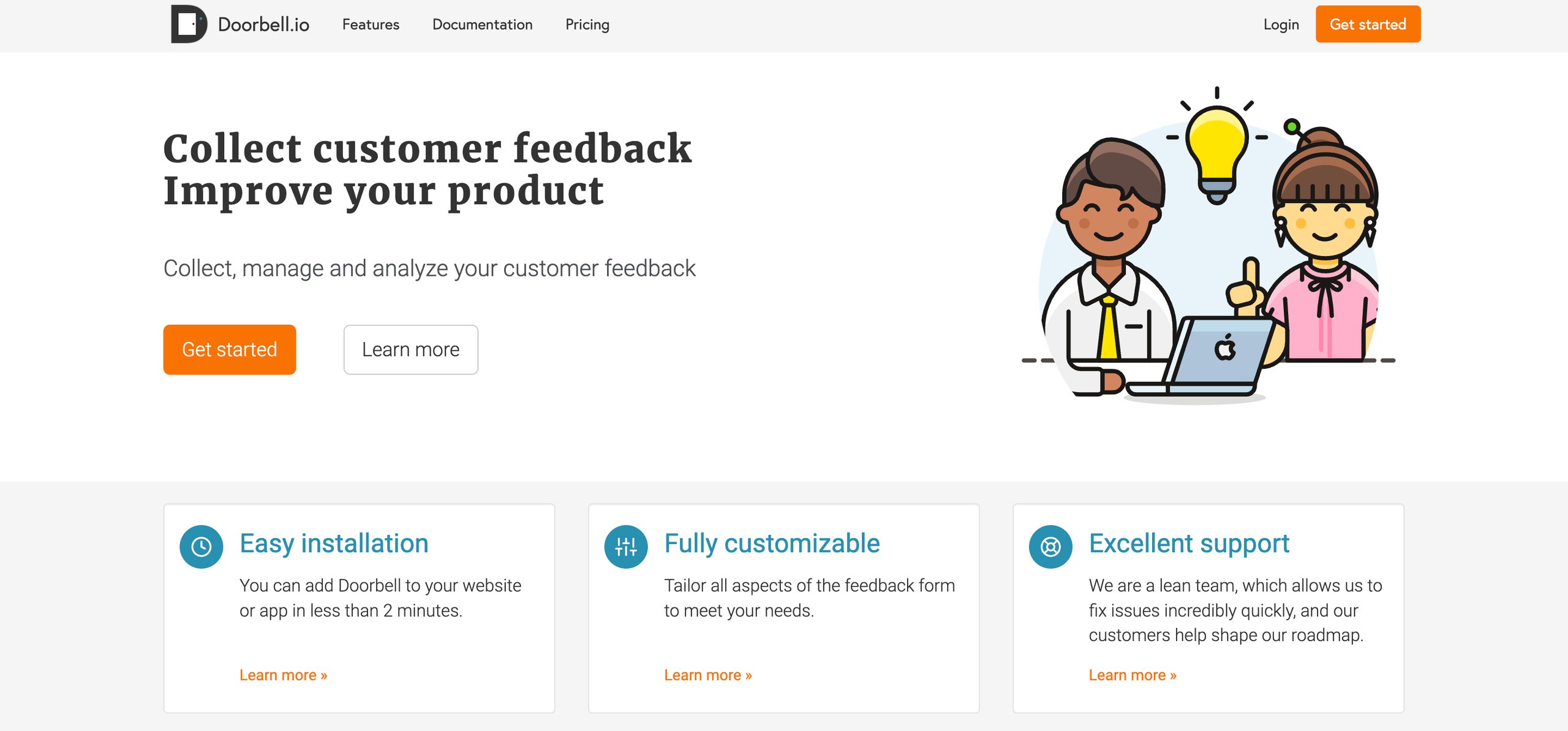
Doorbell is a customer feedback tool designed to help businesses collect, manage, and analyze feedback from users seamlessly.
The platform offers a quick installation process and robust customization options, which enables teams to gather insights that improve products and enhance user experiences.
With 30+ integration options, Doorbell fits perfectly within your existing workflow and makes it easy for teams to respond quickly and turn customer input into targeted improvements.
Top features of Doorbell
Quick installation, customizable feedback forms, 30+ integrations, and instant notifications via email or chat apps.
Pros
- Supports various types of data collection like NPS surveys, and star ratings.
- Affordable pricing makes it easier for smaller businesses to collect feedback.
- Slack integration allows for seamless collaboration with CS and Product teams.
Cons
- Default survey options need to be more user-friendly
- Classification of feedback as positive, negative, or neutral is sometimes inaccurate.
- Lacks a complex understanding of human language and expression
Pricing
Doorbell offers a forever-free plan for up to 2 team members. The paid options start at $29/month for up to 5 team members and include unlimited feedback, team chat integrations, and 50 monthly screenshots.
6. Pendo

Pendo is an AI-powered customer intelligence platform designed to streamline product discovery by capturing, analyzing, and acting on customer feedback.
The tool enables product teams to centralize feedback from multiple sources, uncover trends with AI-driven insights, and validate ideas before development.
Pendo offers a wide range of integrations and automation capabilities that empower teams to make data-backed decisions and craft optimized, impactful experiences.
Top features of Pendo
AI-powered feedback summaries, in-product polls, NPS surveys, advanced filter and targeting options, and product roadmap management.
Pros
- Useful for sending NPS polls to users based on their behaviors
- Easy to create, manage, and customize in-app guides
- Feedback analytics makes it easier to identify trends and prioritize features
Cons
- Limited options to export survey data make in-depth analysis difficult
- Lacks customization options for individual NPS surveys
- Setup and implementation can be challenging, especially for non-tech users
Pricing
Pendo offers a free plan for up to 500 monthly active users (MAUs). The paid options are customized according to your business needs.
7. Mopinion
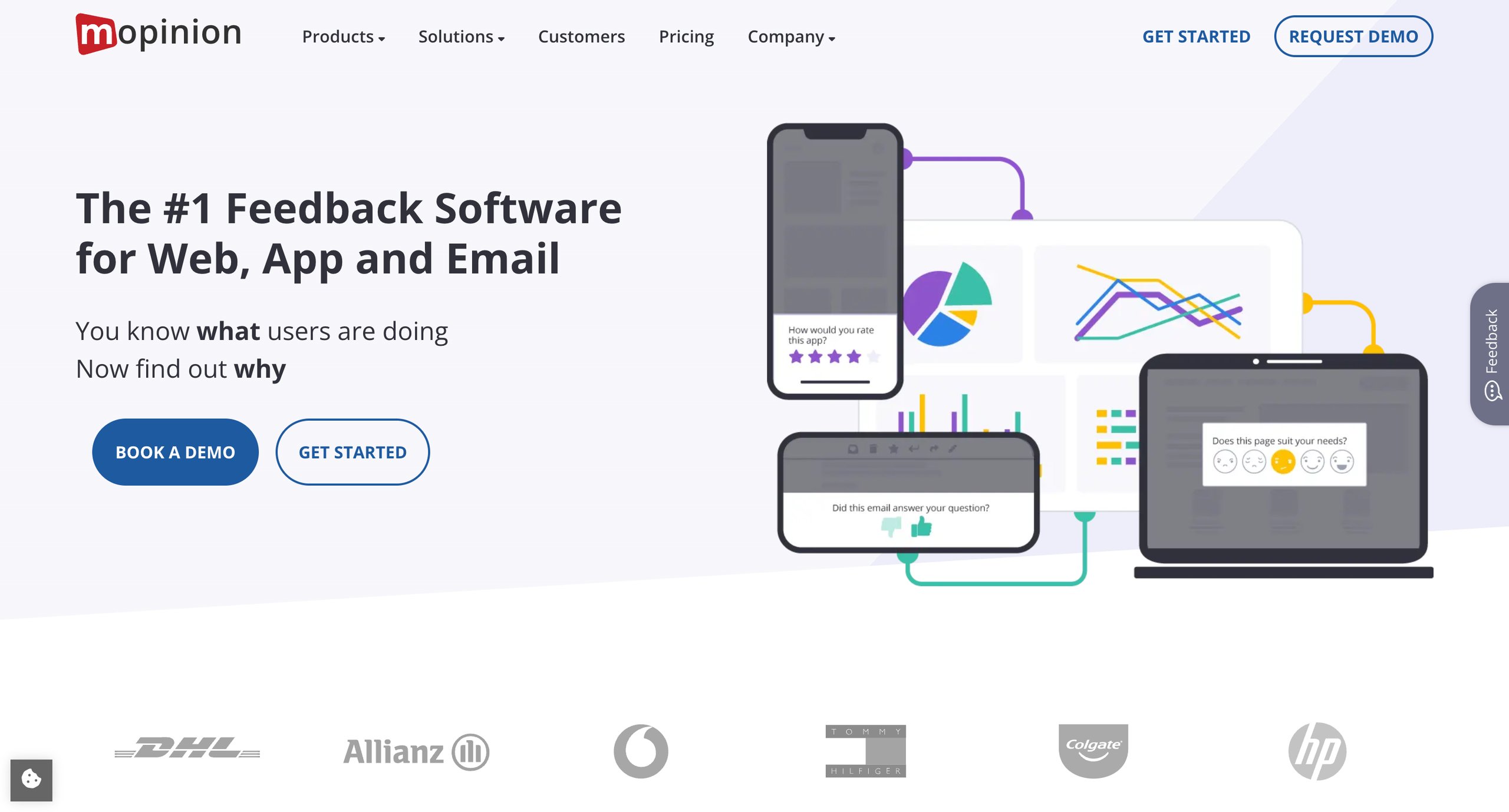
Mopinion is a feedback management tool designed to collect real-time feedback from mobile app users.
The tool’s advanced targeting capabilities ensure that feedback forms are relevant and contextually triggered, enabling teams to understand user needs and optimize the mobile experience.
Mopinion offers customizable surveys and metadata insights which helps businesses to stay ahead of the competition and deliver memorable experiences.
Top features of Mopinion
Flexible SDKs for iOS and Android, drag-and-drop surveys, in-app feedback triggers, advanced targeting, and multi-language support.
Pros
- Offers a wide range of options to gather user feedback
- Allows users to share screenshots along with their feedback
- Intuitive form builder with options to add scales, buttons, text fields, etc.
Cons
- The drag-and-drop builder offers limited options to customize elements
- Analytics dashboard does not have a user-friendly interface
- Does not allow customers to copy previously used forms
Pricing
Mopinion offers a 14-day free trial while the paid options begin at $329/month for 500k monthly pageviews.
8. UserVoice
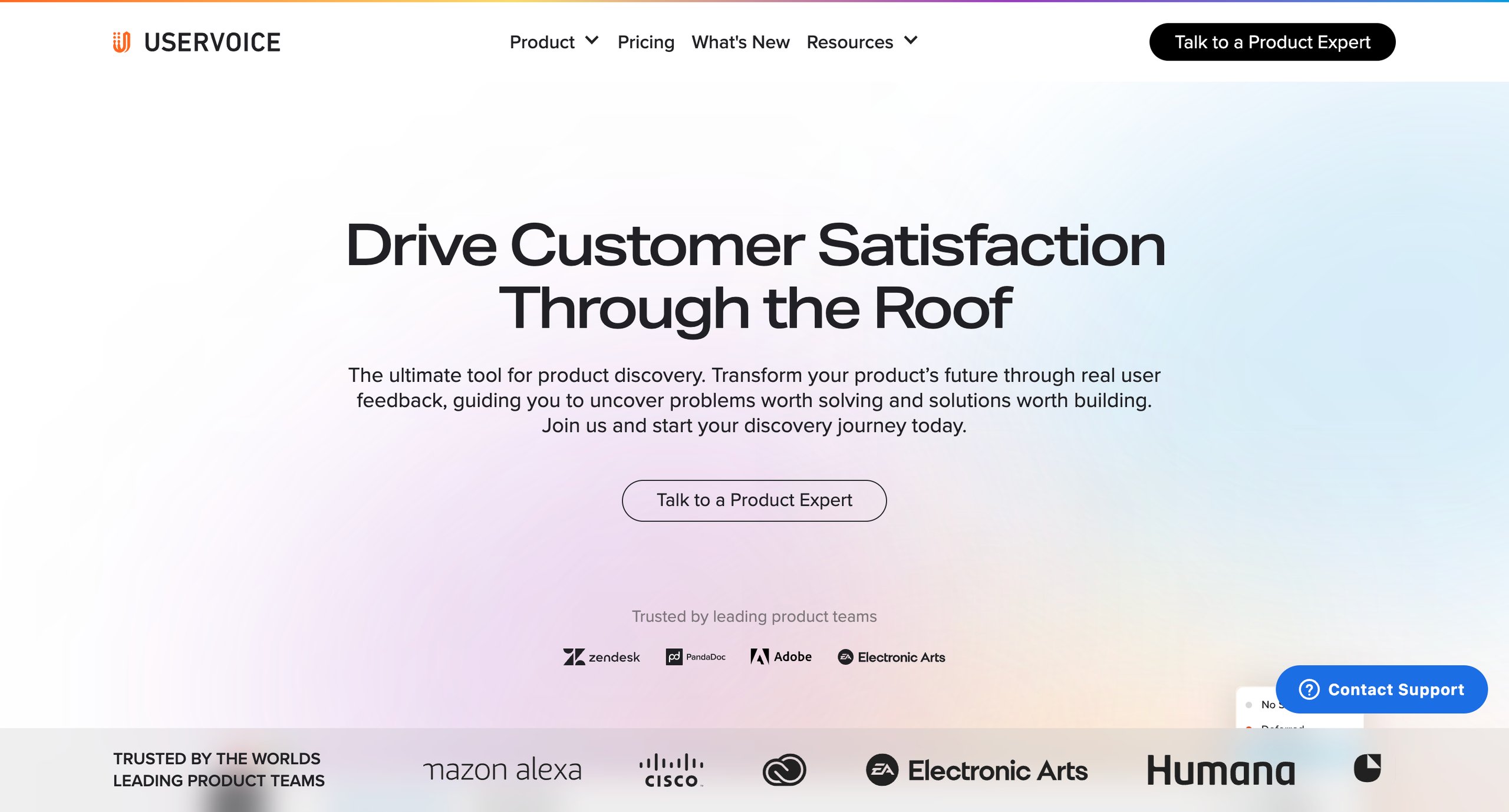
UserVoice is a robust feedback management platform that gathers feedback from multiple channels, empowering teams to uncover valuable insights and prioritize user-driven product improvements.
With features like in-app feedback widgets and branded portals, the tool fosters meaningful engagement with customers, while internal collaboration tools ensure feedback is shared and acted upon seamlessly.
UserVoice also offers advanced analytics and AI-driven capabilities that enable businesses to spot trends, fix UX issues, and convert feedback into measurable impact.
Top features of UserVoice
Centralized feedback collection, in-app feedback widget, advanced segmentation and filtering, AI-powered duplicate idea detection, and an insights dashboard to monitor feedback.
Pros
- Simplifies the process of collecting and organizing feature requests
- Easy for users as well as internal business teams to submit and track ideas
- Useful capabilities like idea management and community building
Cons
- Advanced features are difficult to use, especially for non-tech folks
- The user interface can be difficult to navigate and explore
- Lacks an internal tool to organize and collate feature requests
Pricing
UserVoice offers a Growth plan at $999/month for 1k unique users, while the Team plan is priced at $1,299/month for 3k unique users.
9. Luciq (formerly Instabug)
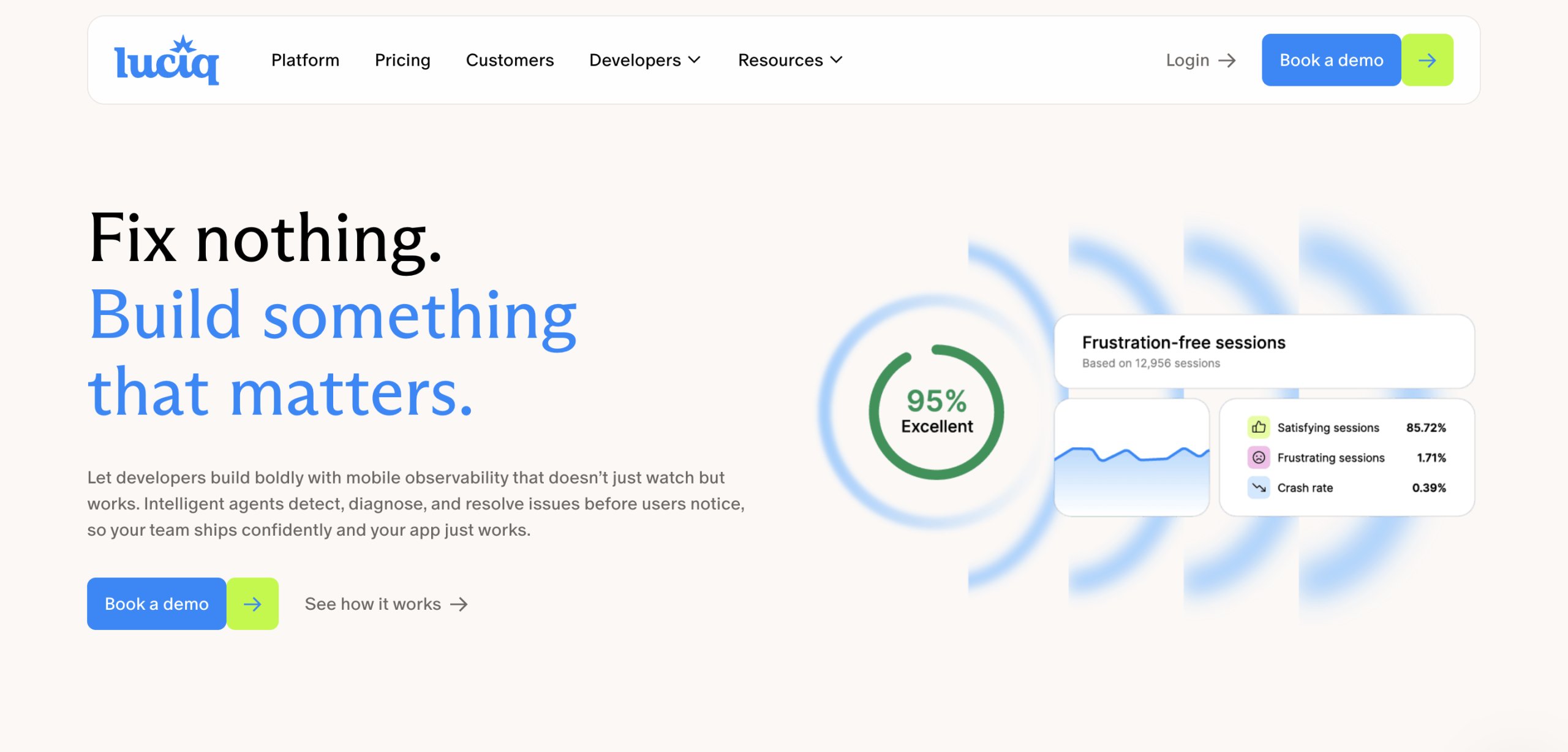
Luciq is a mobile-centric observability platform built to help teams see what happens inside their apps in real time. It captures key signals from user sessions such as crashes, UI glitches, or navigation issues.
The platform is powered by intelligent agents that detect and prioritize issues by business impact, enabling teams to ship features and updates confidently.
Luciq allows you to correlate user feedback with session context, replay sessions around feedback events to see what led users to respond, and streamline resolution workflows.
The real-time insights and user feedback allow businesses to optimize their app experience, boost user satisfaction, and improve app ratings.
Top features of Luciq
Real-time performance monitoring, advanced bug and crash reporting, session replay, AI-driven automation, and a unified dashboard.
Pros
- Captures network logs and snapshots of a user’s recent activity
- Easy for app users to report bugs and crashes
- Useful for detecting and resolving major app issues
Cons
- Pricing is more suitable for larger clients and enterprises
- Reports and filters for bugs need to be improved
- Lacks clear documentation and practical use cases for developers
Pricing
Luciq offers a single customizable plan based on Daily Active Users (DAU) and the number of seats you add.
With VWO’s comprehensive and insightful dashboard, you can easily spot sessions where users experienced app crashes or freezes. Analyze the corresponding session recordings to identify patterns, spot friction points, and prioritize fixes that have the biggest impact on user experience.
10. Appcues
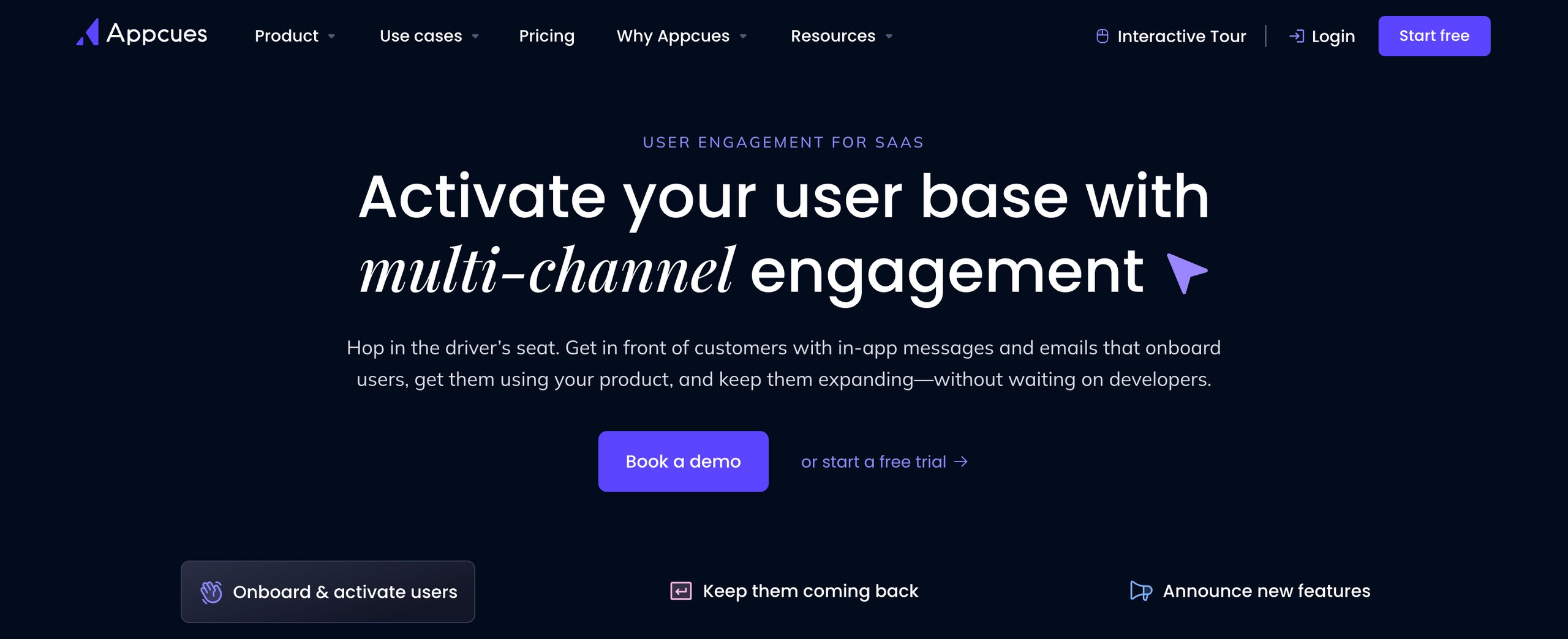
Appcues is a powerful tool for collecting actionable feedback through in-app surveys, NPS tracking, and automated workflows.
The platform enables you to capture user insights, identify opportunities for improvement, keep users engaged, and foster loyalty by turning feedback into meaningful actions.
Appcues simplifies feedback collection and integrates seamlessly with your existing tech stack to drive better decision-making and customer satisfaction.
Top features of Appcues
In-app surveys, automated email responses, NPS surveys, pre-built survey templates, segmentation tools, and sentiment analysis.
Pros
- Requires minimum help from developers for deploying in-app surveys
- Easy to integrate with tools in your existing tech stack
- Advanced segmentation and targeting capabilities
Cons
- Limited customization options for pre-built survey templates
- Does not support more than one live NPS survey at a time
- Expensive for startups or businesses that are just starting out
Pricing
Appcues offers a paid plan at $250/month for 1k monthly tracked users (MTUs).
11. Usersnap
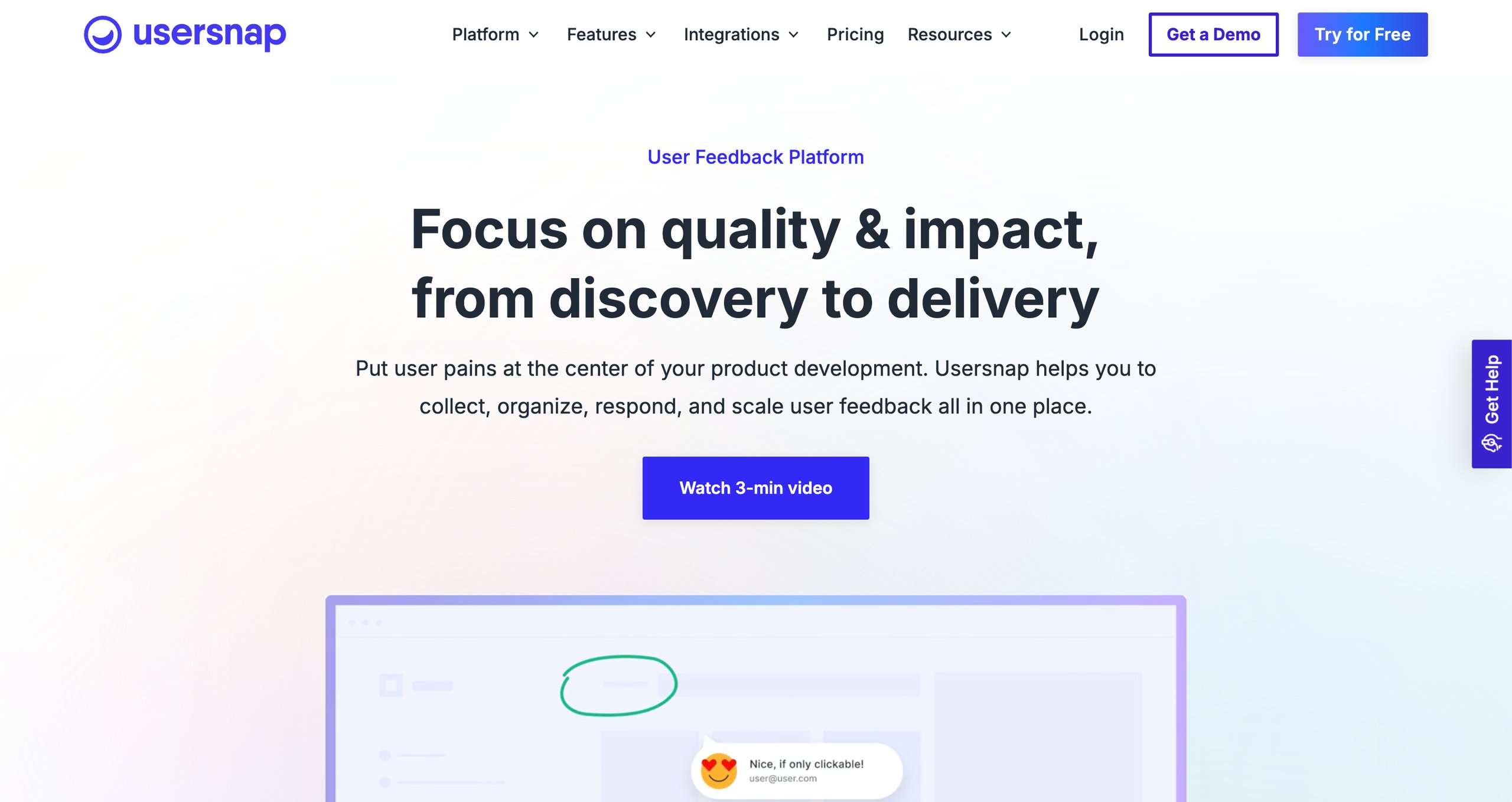
Usersnap is an end-to-end user feedback platform streamlining product-user interactions with capabilities like targeted surveys, and feature request management.
The tool enables teams to gather valuable insights, prioritize feature requests, and make data-driven decisions to deliver user-driven solutions.
Usersnap reduces communication gaps and ensures a seamless process from discovery to delivery, fostering better user satisfaction and continuous improvement.
Top features of Usersnap
In-app visual feedback, targeted surveys, feature request boards, bug reporting, sentiment analysis, and powerful widgets.
Pros
- Useful, out-of-the-box integrations with tools like Jira and Asana
- Reduces the time and effort required by internal teams to report bugs
- Streamlines the feedback process and improves team collaboration
Cons
- Lacks proper documentation on integration with other tools
- Setting up and managing projects can be confusing for new users
- Does not offer integrations with popular CRM tools
Pricing
Usersnap offers a 15-day free trial, while the paid options begin at €49/month with a limit of 2 active projects and 5 seats.
12. Userpilot
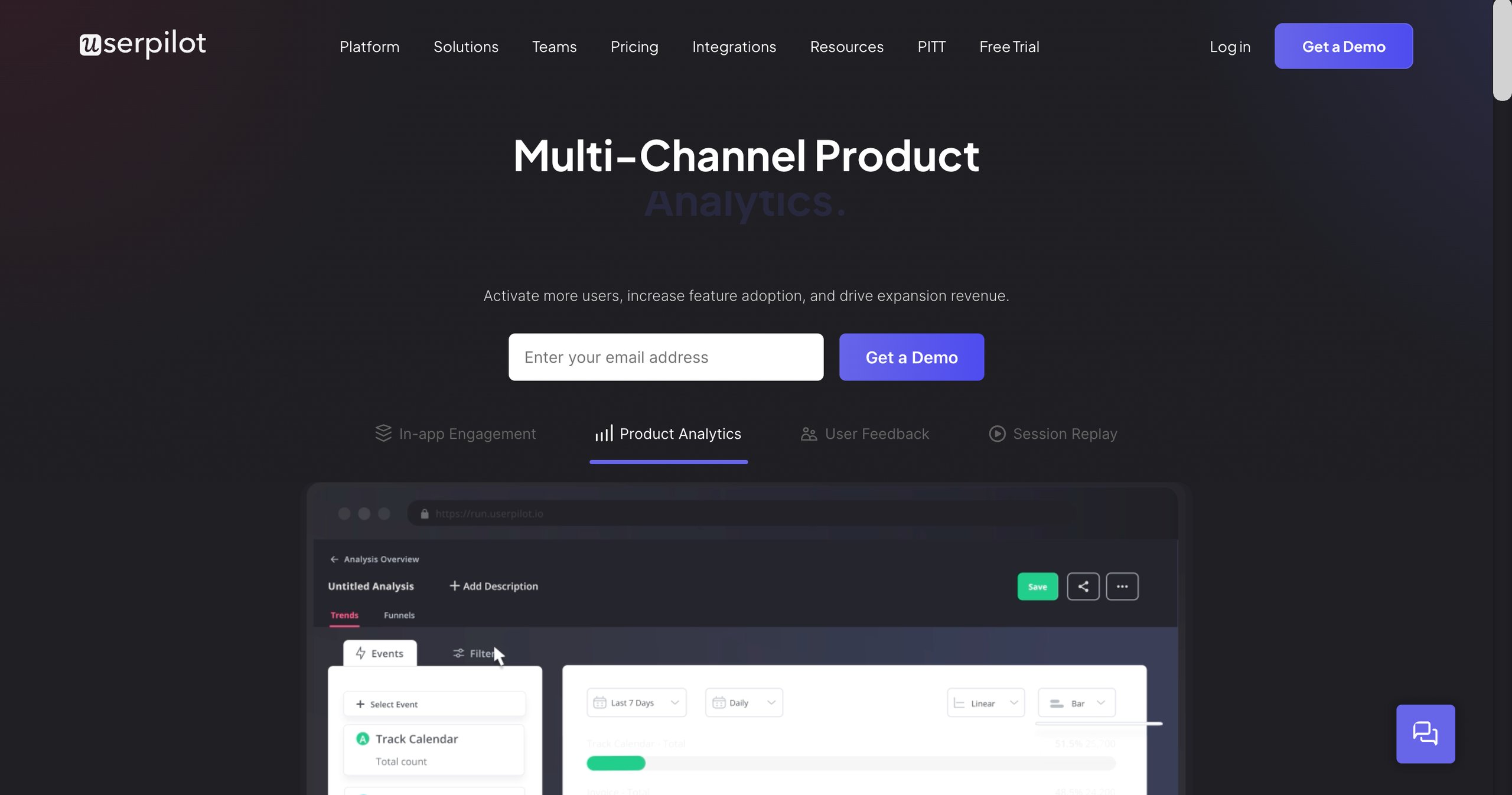
Userpilot is a no-code platform that empowers product teams to create in-app surveys and collect valuable user feedback without engineering support.
The platform enables businesses to launch NPS, CSAT, and other custom surveys with advanced customization and real-time triggering based on user behavior.
Userpilot combines survey insights with product analytics, making it easier for app owners to gather feedback, deliver tailored in-app guides, and improve user satisfaction.
Top features of Userpilot
No-code survey creation, 30+ survey templates, advanced customization with branching logic, real-time survey triggers, and response and completion tracking.
Pros
- The no-code interface simplifies the process of optimizing onboarding journeys.
- Behavior-based targeting is useful for engaging the right users at the right time.
- Easy to set up and get started with in-app messaging
Cons
- Customizing the onboarding process based on unique user needs is challenging.
- Integration with existing tools and workflows is a complex process.
- The analytics dashboard is not suitable for advanced reporting requirements.
Pricing
Userpilot offers a 14-day free trial and the paid options include a Starter plan at $249/month for up to 2k monthly active users (MAUs).
Comparison of in-app feedback tools
| No. | Tool | Free trial | Pricing |
| 1. | Survicate | – | $149/month |
| 2. | Refiner | 30 days | $99/month |
| 3. | GetFeedback | – | Custom |
| 4. | Alchemer | 7 days | $55/month |
| 5. | Doorbell | 7 days | $29/month |
| 6. | Pendo | – | Custom |
| 7. | Mopinion | 14 days | $329/month |
| 8. | UserVoice | – | $999/month |
| 9. | Instabug | 14 days | $299/month |
| 10. | Appcues | 14 days | $250/month |
| 11. | Usersnap | 15 days | €49/month |
| 12. | Userpilot | 14 days | $249/month |
How to collect in-app feedback using surveys?
When done right, surveys can provide actionable insights without interrupting the user experience. Here’s how you can make the most of in-app surveys.

1. Choose the right survey type
Tailor your survey type to the specific insight you’re looking to gain. For instance, NPS (Net Promoter Score) surveys are used to measure overall satisfaction and likelihood of users recommending your app.
On the other hand, CSAT (Customer Satisfaction) surveys are used to gauge user satisfaction with a specific feature or experience.
2. Trigger surveys contextually
Don’t show surveys randomly. Trigger them based on specific user actions or milestones, such as completing a purchase, onboarding, or using a new feature.
This ensures feedback is collected at the right moment or when the experience is still fresh in the user’s mind.
3. Keep surveys short and focused
Long surveys can lead to drop-offs. Limit the number of questions and ensure each one serves a clear purpose.
A single-question survey, like “How easy was it to use this feature?”, can sometimes be more effective than a lengthy questionnaire.
4. Segment your audience
Segment your audience based on factors like user behavior, app version, or geographic location. For instance, users who haven’t completed onboarding might have different feedback to share than long-time users.
5. Close the feedback loop
Don’t leave users wondering if their input was ignored. Acknowledge their feedback, and when possible, let them know how their input has been used.
For example, if a popular feature request is implemented, share an update to highlight the change.
Use customer feedback to run targeted experiments with VWO
While in-app surveys and guides are useful, there are times when users might just leave the app or abandon a process without sharing any feedback.
These issues often go unnoticed and can have a huge impact on retention and engagement.
VWO Insights for Mobile Apps can help tackle these issues with mobile heatmaps, session recordings, funnel analysis, and many other useful capabilities.
For instance, you can use mobile app heatmaps to visualize where users tap on a screen and identify trends or patterns in user engagement.
Also, by observing recordings of how users interact with your app, you can look for specific areas where they struggle and pinpoint the exact factors that influenced their actions.
The best part about VWO is its seamless integration with VWO Mobile App Testing.
So, once you’ve gathered insights and identified the friction areas, you can use them to build a strong hypothesis and run experiments to test different solutions to these issues.

VWO lets you manage your entire optimization program in one place, while also ensuring seamless team collaboration powered by our built-in project management tool VWO Plan.
Request a demo with VWO to explore how you can drive end-to-end optimization for your mobile app.
FAQs
In-app feedback tools are software solutions integrated directly into mobile apps that allow users to share their feedback, report bugs, or provide suggestions while using the app.
These tools often include features like surveys, feedback forms, bug-reporting widgets, screen recordings, and NPS (Net Promoter Score) tracking.
In-app feedback tools help businesses gain insights directly from users while they interact with the product, capturing real-time emotions and context.
They streamline the process of collecting, analyzing, and responding to feedback.
By leveraging these tools, businesses can identify pain points, improve user satisfaction, and address user concerns proactively.
In-app feedback tools can collect a variety of feedback, including:
– Bug reports
– Feature requests
– Usability feedback
– General feedback
In-app feedback tools provide actionable insights that guide product teams in making data-informed decisions.
They help prioritize feature requests, uncover usability issues, and validate ideas based on real user data. This continuous feedback loop reduces guesswork and ensures that product development efforts align with user needs.
Moreover, by addressing issues early, teams save time and resources while delivering a more polished product.
Instead of lengthy email exchanges or support tickets, in-app feedback tools allow users to quickly submit feedback with context, including screenshots, error logs, and recent actions.
This reduces frustration and helps support teams diagnose and resolve problems faster.
By analyzing common issues, product and support teams can proactively address concerns, optimize features, and even reduce the volume of support requests over time.
To collect feedback in-app, integrate feedback widgets or surveys into your app’s UI. Use unobtrusive triggers, such as buttons or pop-ups, that appear at relevant moments (e.g., after completing a task or reaching a milestone).
Also, you must ensure that feedback forms are simple, visually appealing, and customized to your app’s branding. Offering incentives or follow-ups, like thank-you messages, can also encourage participation.
To gather feedback for an application, use multiple channels, including in-app surveys, app store reviews, email campaigns, and social media.
Encourage users to share their thoughts by integrating feedback prompts at relevant touchpoints, like after completing a purchase or using a new feature.
Additionally, you can actively engage with popular communities to gather organic feedback.
Strategically timed feedback requests ensure higher response rates and more actionable insights. Ask for feedback:
– After users complete key actions (e.g., making a purchase, completing onboarding).
– When users reach milestones (e.g., using the app for a week or achieving a goal).
– After launching a new feature or update
The questions you ask should depend on your goals. Ensure your questions are concise and relevant to the user’s journey within the app. Here are some examples:
– “What do you like most about the app?”
– “What features do you think are missing?”
– “How easy was it to complete [specific action]?”
– “How would you rate your experience?”
– “What can we improve to make [app name] better for you?”
In-app feedback refers to the process of collecting user opinions, suggestions, or complaints directly within an application.
This type of feedback is contextual, as it captures the user’s experience in real time while they interact with the app.







![5 Best Free App Analytics Tools in 2026 to Boost App Performance [Research-Backed Picks]](https://static.wingify.com/gcp/uploads/sites/3/2025/04/Feature-image-5-Top-App-Analytics-Tools_-Solutions-to-Improve-Your-App-Performance.jpg?tr=h-600)











